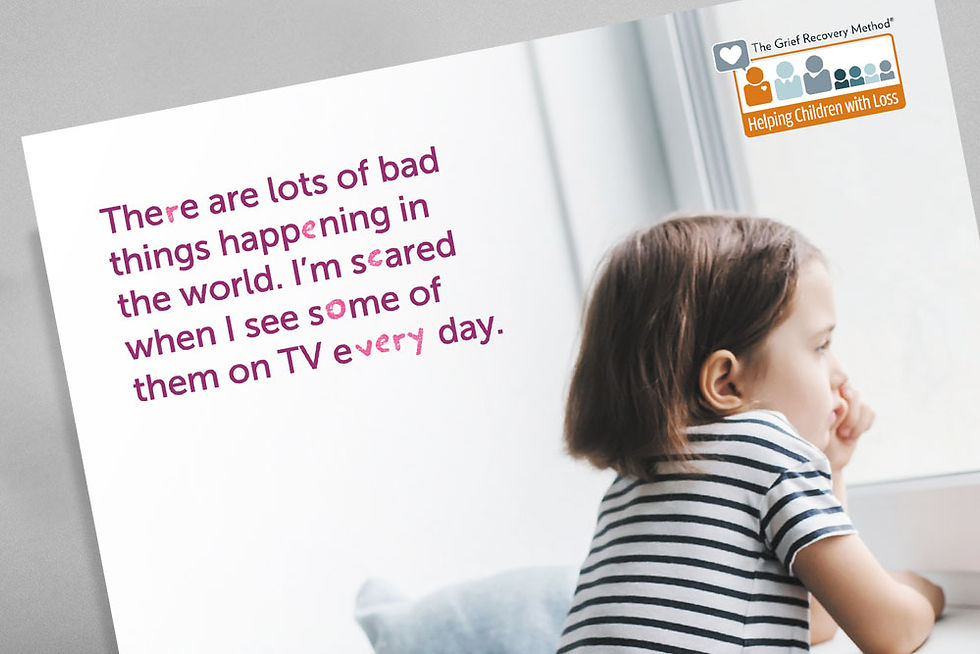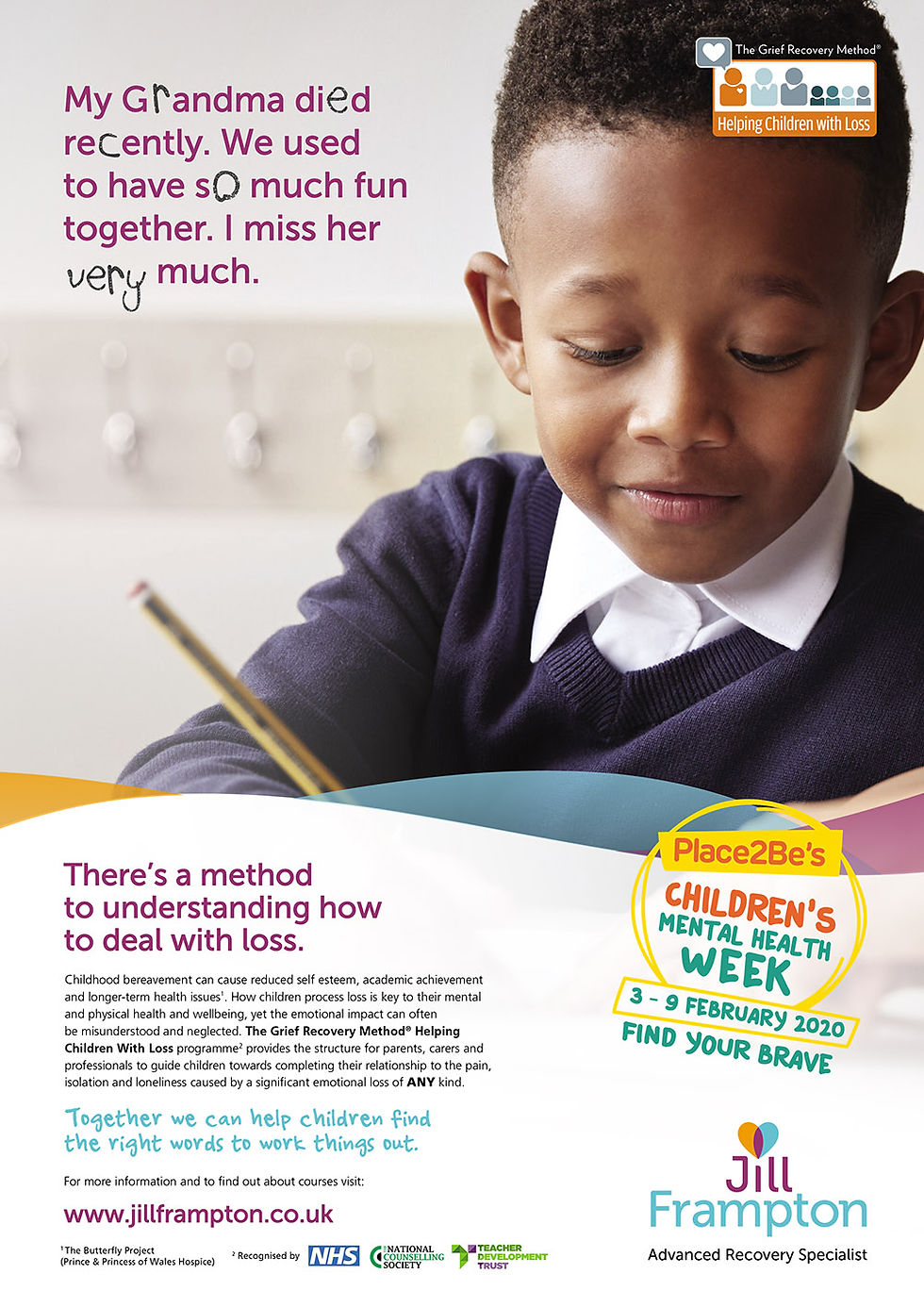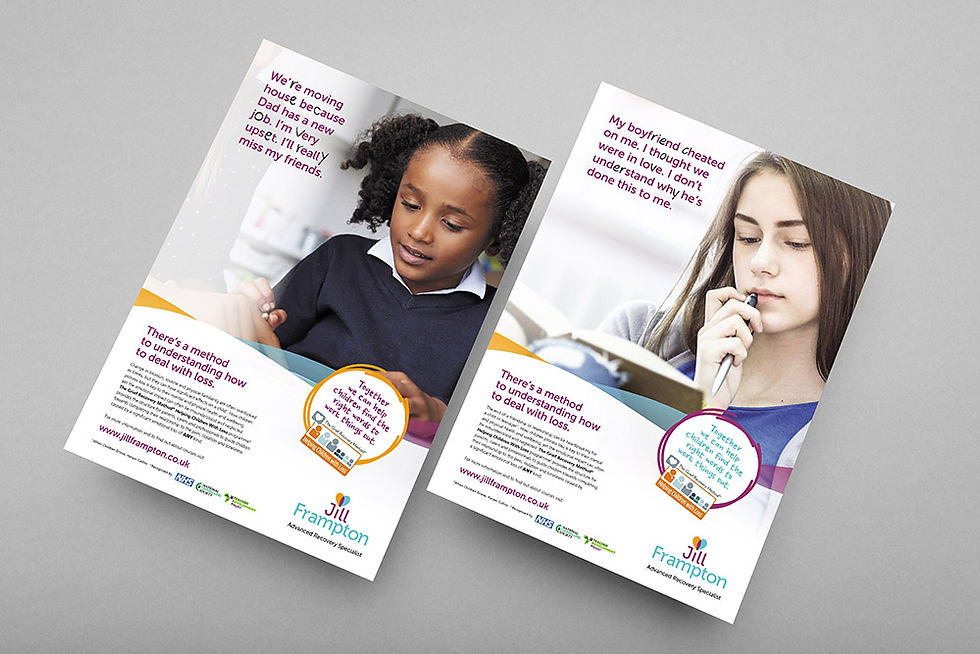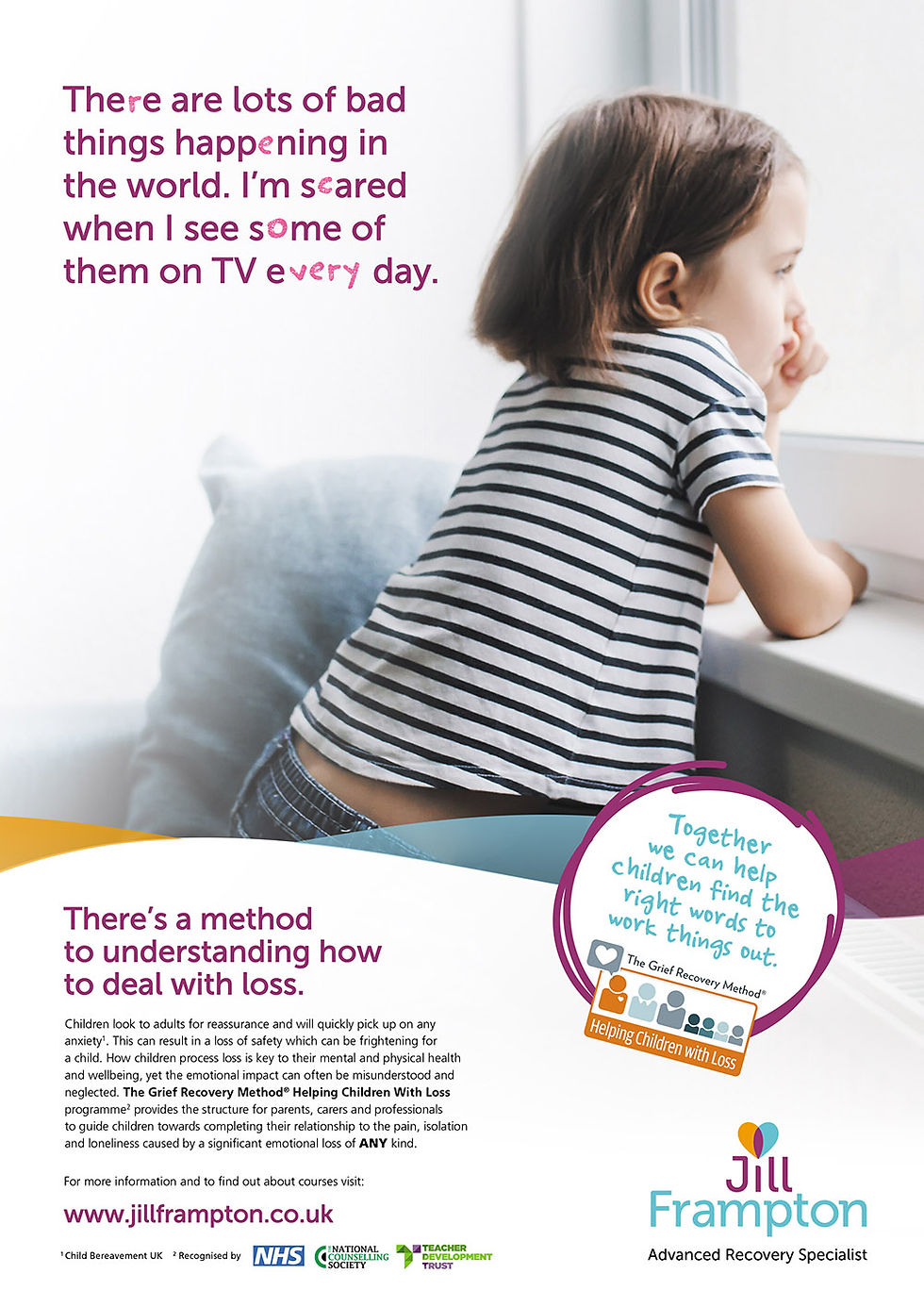Communicating and Helping Children With Loss
- Steve Frampton

- Apr 12, 2020
- 7 min read
Updated: Apr 14, 2020

For all of us, normal life as we know it has currently been turned upside down by the Corona virus pandemic. It's a very uncertain and anxious time for billions of people around the globe and for children especially, there are many losses such as changes in routine, not being able to go to school, see their friends or simply go out and play that can be frustrating, confusing and worrying. Children also pick up on anxiety very quickly [1]; things children hear their parents talk about and the images they may see on TV can be upsetting and scary for them to understand.
Being open and honest with children is paramount, and amidst the very significant, yet anomalous event that we're all presently experiencing, now more than ever highlights this importance. As a subject close to me personally, I wanted to produce something to visually communicate the significance of children's loss and how we, as adults can guide and support children during this difficult time and subsequently afterwards and throughout their childhood.
Loss and resulting grief are difficult subjects to broach and often we can be unsure of what to do and say for the best. They are also frequently misunderstood, neglected and associated specifically and erroneously with bereavement and ‘physical’ death [2]. In actuality, GRIEF IS THE NORMAL AND NATURAL REACTION TO LOSS OF ANY KIND [3].
The are over 47 kinds of loss [3] and for children, one of the most commonly experienced losses whilst growing up is perhaps the death of a grandparent(s) but, as aforementioned, loss can also be nothing to do with death; it can be due to moving house, changing school, divorce of parents, debilitating injury, illness or disability, break up of a friendship or relationship, loss of trust or the loss of a pet to name but a few.
Regardless of how small or even insignificant some of these losses may appear to us as adults, losses can be cumulative and can affect children many years into adulthood if not dealt with; and this occurs time after time, causing worry, confusion and distress.
Frequently and often involuntarily, when loss affecting a child occurs it can be repeatedly commonplace for us to resort to what we were taught by our own parents which was / is that ‘unhappy and sad feelings are bad and should be hidden or kept to yourself’ instead of openly engaging with the child in order to alleviate their concerns.
Surely it's better to allow and encourage children to talk about something that is worrying them? Is it not without question, more sensible to explain things to children that would alleviate those worries, so that they understand things that might otherwise scare or upset them? Is it not more fitting to help them to process and understand their feelings and emotions in an appropriate and open manner instead of ignoring or dismissing them?
It was these questions and considerations that compelled me to find a way to visually communicate some of the individual and relatable losses children may face when growing up, inform on how these losses affect children and to promote ‘Helping Children With Loss’, a scientifically-proven, evidence based programme which is a part of Grief Recovery UK’s Grief Recovery Method® that my wife Jill, an Advanced Recovery Specialist and Mental Health Consultant is trying to raise awareness of and to help families throughout Staffordshire.

COMMUNICATING LOSS EXPERIENCED BY CHILDREN: OBJECTIVE
The objective was to produce a campaign consisting of a set of adverts/visuals for print, web and social media (there are six adverts altogether) that could also be resized into posters and pull-up banners specifically for Jill to use. The campaign needed to impart ‘loss’ in some sort of visual way; the initial thought/idea was to create the adverts by only using typography/text with certain letters or words removed to convey the ‘loss’ itself. However, whilst sitting in the waiting area for a routine Asthma review at our local Health and Wellbeing Centre I saw an advert for the NHS on the wall about Dementia where parts of letters were missing to indicate a loss of memory.
If grief and loss are natural [1], why do we think of them as feelings and emotions that are fundamentally bad or even abnormal?
TEXT AND TYPE: JUSTIFICATION
Subscribing to the notion that there should be a rationale behind every element placed on a page, i.e. the typeface(s), imagery, strap line, body copy, colour and the necessity to justify those component parts via research, reading, talking to the client, understanding the problem and reflection in order to achieve the best result/solution; I felt it was too easy (and lazy) to just copy an idea that I’d seen elsewhere, even though it had been used for a different subject. I wanted it be something that I hadn't seen or done before and that was specific to the client.
As mentioned beforehand, loss and grief are complicated subjects and individual to each person. This in turn created issues in effectively trying to illustrate and communicate 'loss' in a simple visual way. Using missing letters or words to create spaces within words and sentences felt over-complicated, had the potential to be misread, misunderstood and / or require and expect too much of the reader to want to 'fill in the gaps' by themselves.
IMAGERY: JUSTIFICATION
The decision was therefore made to use photography as a component part of the visuals to complement text/type. It was felt that the most effective way to communicate how the child in question was/is processing and understanding their loss in an appropriate and effective way was as follows:
1. By using an image of a child (the 'experiencer' of the loss) shown in a safe and recognisable location that also intimates at the adult/parent/carer/teacher that is working with/alongside the child
2. Creating suitable text/copy conveying a loss appropriate for the child’s age along with identification and understanding of that loss by the relevant adult and the processing of that loss by the child

Consciously finding the 'right' imagery to use required a lot of thought and a search through hundreds of royalty free photographs [4] online (it was considered too expensive to create new/bespoke photography for this project). Photos depicting a child either working with an adult or teacher or perhaps in the case of older children, a teenager processing their particular loss in their own space and time, were deemed to be the most appropriate rather than showing a child that was visibly upset, in distress or alternately, noticeably ‘happy’.
The justification for this was because the Helping Children With Loss programme takes place after the loss, but prior to recovery. At this ‘support stage’ the image should therefore show thought, understanding, contemplation, care, positivity, acceptance, wellbeing, education, teaching, advice, coming to terms, learning, safety, methodology, problem solving, processing, reflection and progress.
TYPOGRAPHY
Two different typefaces were chosen, the first, a sans-serif typeface [5] to denote the specific loss experienced / identified and the second, a bespoke, illustrated children’s handwriting style particular to the child / child's age in the photo to communicate the child's thinking, processing and understanding of their loss, helped by the adult in an environment that is comfortable and safe for them. The text/type to communicate the ‘loss’ was then applied in conjunction with a main ‘hero’ image of the child to tell a story / provide a back-story / picture / scenario.

STRAP LINE
The word ‘Method’ both in reference to the ‘way/understanding/process’ in which a child should be guided and supported and the Grief Recovery ‘Method’ itself was considered necessary as that is what the programme/course is all about - teaching people the correct way of how to help children with loss and to find the appropriate solution. The final strap line, ‘There’s a method to understanding how to deal with loss’ was concluded from these considerations.
BODY COPY
It was felt that a couple of paragraphs of body copy were required on each advert just to provide a little more explanation of the specific loss in question and how the Helping Children With Loss programme can help adults, parents, carers and professionals help the children in their care. The advert completes with the words ‘Together we can help children find the right words to work things out’ with contact details bottom left and logo / company branding bottom right (Call to action).
HIDDEN WORD
As an added 'extra', each child's handwriting spells out the word 'Recovery'. I don't think it's essential that it's noticed or to convey the required message but it's there if you do spot it!
CONCLUSION
Despite the complexities of the subject and message this has been a project that I have thoroughly enjoyed working on. Helping Children With Loss is something very important to both my wife Jill and I for different reasons. For Jill, it was the death of two young children and the effect that had on her physical and emotional health and wellbeing along with her family and her young son Tom as he battled to understand the loss of his little brother and sister as he grew up. (Please read more about Jill and Tom's experience here).
For me personally, it was the loss of the ability to walk at the age of 13 years old after a very rare, yet devastating virus (Guillain Barré Syndrome / Acute Inflammatory Demyelinating Polyneuropathy) that attacks the nervous system leaving me with significant nerve damage, pain, partial paralysis and subsequent and significant problems, both physically and emotionally as a child and later on, in the years of recovery that followed. (Please read more about my experience here).
Loss comes in many forms and is always individual to those experiencing it. Only now, many years later have we (Jill, Tom and myself) been able to come to terms with our losses having completing The Grief Recovery Method® for ourselves as adults.
The impact these losses have had could have been significantly reduced if this pivotal help and support had been available at the time those losses occurred and this is why I wanted to help communicate and promote Helping Children With Loss.
You can see all of the adverts here. I would be grateful for feedback. If you have any questions regarding the adverts or the Helping Children With Loss programme. It would be great to hear from you and get people involved! Thanks for reading.
REFERENCE
[1] Child Bereavement UK
[2] When Children Grieve – John W.James and Russell Friedman with DR Leslie Landon Matthews. HarperCollins ISBN 978-0-06-008429-5
[3] The Grief Recovery Handbook – John W.James and Russell Friedman. HarperCollins ISBN 978-0-06-168607-8
[4] All photographs are royalty free and purchased with license from Adobe Stock.
[5] Museo Sans – Sturdy, low contrast, geometric, highly legible sans serif typeface very well suited for display and text. (Jill Frampton’s corporate branding primary typeface)




Comments